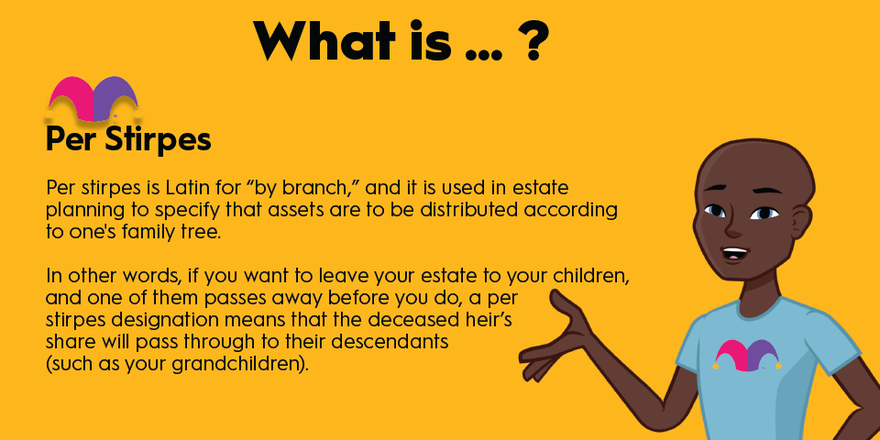One of the most important parts of estate planning is making a will, and when you make yours, there are a couple of different ways you can choose to divide your assets among your heirs. Per stirpes is one of these ways, and for many people it is the preferred way to set up asset transfer upon death. Let's look at what per stirpes means, an example, and whether it’s better than the alternative.

What is per stirpes?
What is per stirpes?
Per stirpes is Latin for “by branch,” and it is used in estate planning to specify that assets are to be distributed according to one's family tree.
In other words, if you want to leave your estate to your children, and one of them passes away before you do, a per stirpes designation means that the deceased heir’s share will pass through to their descendants (such as your grandchildren).
There are two main ways assets can be distributed according to the terms of a last will and testament: per stirpes and per capita. Per stirpes divides the estate into equal shares to be paid according to the family tree distribution described above. Per capita means “by heads,” and divides the estate only among living heirs.
Example: Per stirpes vs. per capita
Example: Per stirpes vs. per capita
Let’s say that you’re unmarried and have three children: Michael, who has two children, Alex, who has one child, and Christina, who has three children. If you make all three of your children your heirs, and they are all alive at the time of your death, your estate will be divided among the three of them equally.
However, let’s say that Michael passes away before you do.
If you left your estate to your heirs per capita, Michael’s children would get nothing. Your estate would be divided between Alex and Christina. Each would inherit 50% of your assets.
On the other hand, if your will left your estate per stirpes, your estate would still be divided in thirds. Alex and Christina would each receive one-third, and the remaining third would be divided between Michael’s two children.
Per stirpes considers only direct descendants. In other words, if your child passes before you, their children inherit their share of your estate. Spouses are not included in the distribution. So even if Michael was married at the time of his death, his spouse wouldn’t be entitled to receive a share of the estate.
Of course, this is a simplified example, but it gives you the general idea of the difference between per stirpes and per capita.
Why is per stirpes important?
Why is per stirpes important?
A per stirpes designation in a will can be used to ensure that all your heirs (and their heirs) are accounted for when it comes time to divide the estate. For example, if you want to make sure your grandchildren get a piece of your assets even if your children die before you do, a per stirpes designation in your will can make sure that will happen.
Which is better, per stirpes or per capita?
Which is better, per stirpes or per capita?
Obviously, every estate planning situation is different, so there is no one-size-fits-all answer. And if a person dies while their heirs have no children or other direct descendants of their own, per stirpes and per capita are effectively the same thing. But if you’re planning to put a will in place, the designation you choose could have big ramifications.
In most cases, a per stirpes designation in a will ensures that your heirs and their families will receive a proportional share of your estate after you die, even if your direct descendants die before you. But the best designation for you depends on your preferences and your circumstances.






































































